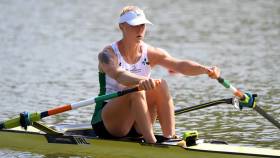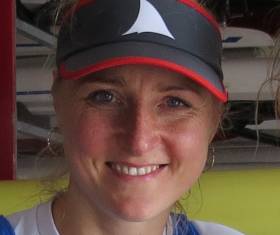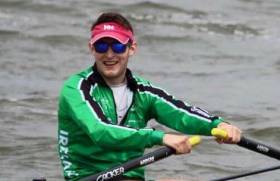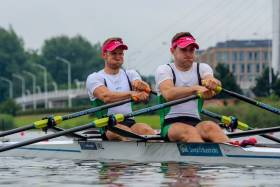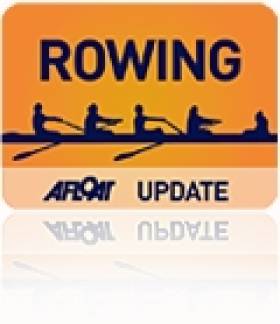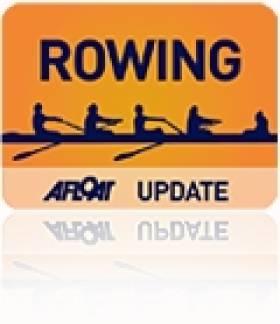Displaying items by tag: SemiFinal
#Rowing: Ireland’s women’s pair of Claire Feerick and Eimear Lambe qualified for the semi-final at the World Cup Regatta in Poznan, Poland. The young crew took a clear second place behind Megan Kalmoe and Tracey Eisser of the United States in their repechage. The USA One crew were clear winners, while Feerick and Lambe did well to win a battle with Canada One to claim the second – and final – qualifying spot.
World Cup Regatta, Poznan, Poland, Day One (Irish interest)
Women
Four
Heat One (First Three to A/B Semi-Finals; rest to Repechage): 1 Australia 6:32.50, 2 United States Two 6:33.57, 3 Britain 6:35.69; 4 Ireland (T Hanlon, M Dukarska, A Crowley, E Hegarty) 6:38.44.
Pair
Heat Two (Winner to A/B Semi-Final; rest to Repechages): 1 Italy Two 7:07.10; 2 China Two 7:09.55, 3 Ireland (E Lambe, C Feerick) 7:10.31. Repechage One (First Two to A/B Semi-Final; next two to C Final; rest to D Final): 1 United States One 7:15.35, 2 Ireland 7:19.33; 3 Canada One 7:26.52.
Puspure Wins Semi-Final to Take A Final Place at World Rowing Championships
#Rowing: Sanita Puspure won her semi-final and progressed confidently to the A Final of the single sculls at the World Rowing Championships in Plovdiv, Bulgaria. While Fie-Udby Erichsen of Denmark staged an early challenge and led, Puspure swept through her as they approached the 1,000 metres. She then powered away and won with two lengths of clear water to spare.
Carling Zeeman was a good tip to join the two in the A Final, but caught a crab which momentarily stopped her boat. Annekatrin Thiele took the third and final qualifying spot.
Jeannine Gmelin of Switzerland won the second semi-final from Kara Kohler of the United States, with Magdalena Lobnig of Austria just squeezing out Madeleine Edmunds of Australia for the third A Final spot. Gmelin’s time was just .92 of a second off Pupure’s.
World Rowing Championships, Plovdiv, Bulgaria, Day Six (Irish interest)
Men
Double – Semi-Final One (First Three to A Final; rest to B Final): Britain 6:06.59, 2 New Zealand 6:08.00, 3 Romania 6:08.17; 5 Ireland (P Doyle, R Byrne) 6:10.95.
Women
Eight – Repechage (First Four to A Final): 4 Britain (8 R Shorten) 6:04.63.
Single Sculls – A/B Semi-Final (First Three to A Final; rest to B Final): 1 Ireland (S Puspure) 7:23.01, 2 Denmark (F-U Erichsen) 7:30.73, 3 Germany (A Thiele) 7:32.74.
Gutsy Performance Secures A Final For Puspure at World Rowing
#Rowing: Sanita Puspure secured an A Final spot at the World Rowing Championships today. The Old Collegians sculler took a close-up second in her semi-final of the single sculls. Puspure produced an intelligent, gutsy performance. In a tight contest she moved at halfway to secure a place in the top three; after the 1500 metres mark she charged again, and was just three-hundredths of a second behind Jeannine Gmelin of Switzerland, who qualified in first. Behind them, Magdalena Lobnig of Austria just ousted Felice Mueller of the US for third.
World Rowing Championships, Sarasota-Bradenton, Day Six – Irish interest:
Women
Single Sculls – Semi-Final Two (First Three to A Final; rest to B Final): 1 Switzerland (J Gmelin) 7:26.90, 2 Ireland (S Puspure) 7:26.93, 3 Austria (M Lobnig) 7:27.79; United States (F Mueller) 7:27.89.
Semi-Final One: 1 Britain (V Thornley) 7:31.72, 2 Netherlands (L Scheenard) 7:34.09, 3 Canada (C Zeeman) 7:34.33.
O'Donovan and Lightweight Pair Race Into World Rowing Finals
#Rowing: Paul O'Donovan won his semi-final after another exciting tussle and the Ireland lightweight pair also qualified for their A Final at the World Rowing Championships in Rotterdam today.
Lightweight sculler O'Donovan put in a remarkable middle third of the race to move from sixth to second in very hot conditions . He then pushed for the lead, but Rajko Hrvat of Slovenia was a dogged opponent. The two raced to the line - O'Donovan won by just over half a second.
Mark O'Donovan and Shane O'Driscoll reached their A Final by taking second. They raced France for most of the 2,000 metres and were still in touch at the end.
World Rowing Championships, Rotterdam (Irish interest; selected results)
Men
Lightweight Pair A/B Semi-Final Two (Three to A Final; rest to B Final): 1 France 6:30.56, 2 Ireland (M O'Donovan, S O'Driscoll) 6:32.18, 3 United States 6:33.19; 4 Brazil 6:35.07, 5 Italy 6:37.34, 6 Spain 6:40.82.
Lightweight Single Sculls - A/B Semi-Final One (Three to A Final; rest to B Final): 1 Ireland (P O'Donovan) 6:51.71, 2 Slovenia 6:52.31, 3 Germany 6:52.32; 4 Spain 6:53.21, 6 Italy 7:17.33.
Under-23 Quadruple Sculls - B Final (Places 7 to 12): 1 Russia 5:54.0; 6 Ireland (D Buckley, J Casey, P Boomer, S McKeown) 6:01.78.
O'Donovans Secure Second Olympic Rowing Final Place for Ireland
#Rowing: Paul and Gary O'Donovan lifted Ireland into a second Olympic final at Rio de Janeiro today. The men from Lisheen near Skibbereen finished third in their semi-final of the lightweight double sculls. France and the United States set the early pace, with Britain third and Ireland in fourth. The O'Donovans took a marginal lead over Britain at half way and then hunted down the leaders. France held on to take first ahead of the United States, who had just over a half a second over Ireland.
South Africa won the second semi-final, pushing Norway in to second. Poland won a battle for third with Italy. The winning time - six minutes 38.01 seconds - was over three seconds slower than that in Ireland's semi-final.
Olympic Games, Rio de Janeiro (Irish interest; selected results)
Men
Lightweight Double Sculls - Semi-Finals (First Three to A Final; rest to B Final)
Semi-Final One: 1 France 6:34.43, 2 United States 6:35.19, Ireland (G O'Donovan, P O'Donovan) 6:35.70; 4 Britain 6:38.76, 5 Germany 6:59.28, 6 China 7:01.49.
Semi-Final Two: 1 South Africa 6:38.010, 2 Norway 6:38.65, 3 Poland 6:40.23.
Women
Lightweight Double Sculls - Semi-Finals (First Three to A Final; rest to B Final)
Semi-Final One: 1 South Africa 7:19.09, 2 New Zealand 7:19.27, 3 China 7:20.94.
Semi-Final Two: 1 Netherlands 7:13.93, 2 Canada 7:16.35, 3 Ireland (C Lambe, S Lynch) 7:18.24; 4 Denmark 7:20.29, 5 United States 7:22.78, 6 Germany 7:33.21.
Puspure Books Place in Olympic Qualification Final
#Rowing: Sanita Puspure has qualified for the final of the Olympic Qualification Regatta in Lucerne, Switzerland. The Ireland single sculler finished second in the semi-final behind Emma Twigg of New Zealand, with Elza Gulbe of Latvia taking the third qualification place. Twigg and Puspure were clear in the first and second places from early on, with Gulbe making third her own in the second half, well clear of the other three contenders, from Russia, Spain and Norway.
Denmark’s Fie-Udby Erichsen of Denmark won the second semi-final, with Ekaterina Karsten of Belarus and Nataliya Dovgodko of Ukraine taking the other final places.
The first four scullers in tomorrow’s final will book their places at the Olympic Games.
Olympic Qualification Regatta, Lucerne, Switzerland (Irish interest; selected results)
Women
Single Sculls – Semi-Finals (Three to A Final) – Semi-Final One: 1 New Zealand (E Twigg) 7:36.75, 2 Ireland (S Puspure) 7:40.46, 3 Latvia (E Gulbe) 7:46.69. Semi-Final Two: 1 Denmark (F Erichsen) 7:37.09, 2 Belarus (E Karsten) 7:41.89, 3 Ukraine (N Dovgodko) 7:42.18
Jegou's Penalty-Free Run Not Fast Enough To Secure Olympic Place
#Canoeing: Ireland C1 paddler Liam Jegou finished outside the top 10 nations at the canoe sprint World Championships in Lee Valley in England today and missed out on this chance of qualifying the boat for the Olympic Games. Jegou went off second in his semi-final and had a penalty-free run down the course, but his time of 106.29 seconds was not fast enough to stand in the top 10 nations. Jegou came in 27th, ahead of Italy and Canada. Spain, Portugal and Australia also missed out.
Canoe Slalom World Championships, Lee Valley, London, Day Five (Irish interest)
Men
C1 – Semi-Finals (10 to Final): 27 L Jegou 106.29
K1 – Team Final: 19 Ireland 161.62
#ROWING: Ireland’s new women’s double of Helen Hanningan (neé Walshe) and Monika Dukarska made a significant breakthrough at the World Rowing Championships in Amsterdam today, qualifying for the A/B Semi-Finals. The target was a place in the top two of their repechage. Romania made the early pace, with Ireland and the United States joining them in the challenge. By the closing stagest the US had their place sewn up, while Dukarska and Hannigan took out Romania to enter the top 12 crews at the Championships.
World Rowing Championships, Day Four (Selected Results; Irish interest)
Men
Lightweight Single Sculls – Quarter-Final (First Three to A/B Semi-Finals; rest to C/D Semi-Finals): 1 Germany (L Hartig) 7:13.67, 2 Ireland (P O’Donovan) 7:14.76, 3 Denmark (S Jensen) 7:33.91; 4 Azerbaijan 7:25.84, 5 Russia 7:33.91, 6 Algeria 7:43.76.
Women
Double Sculls – Repechage Three (First Two to A/B Semi-Final: rest to C/D Semi-Final): 1 United States (M O’Leary, E Tomek) 7:18.10, 2 Ireland (H Hannigan, M Dukarska) 7:21.14; 3 Romania 7:22.87, 4 Estonia 7:48.85.
Lambe Qualifies for Youth Olympic Rowing Semi-Final
#ROWING: Ireland’s Eimear Lambe qualified for the A/B semi-finals of the Youth Olympic Games in Nanjing in China this morning. The 17-year-old Dubliner, a sister of senior Ireland international Claire, took the second qualification spot behind Anna Thornton of Britain. Lambe is drawn to compete in the first semi-final at 3.40 am Irish time tomorrow (Tuesday) morning.
Youth Olympic Games, Nanjing, China (Irish interest, selected results)
Women
Junior Single Sculls – Repechage Two (First Two to A/B Semi-Finals): 1 Britain (A Thornton) 3:53.67, 2 E Lambe 3:55.00; 3 Denmark 3:57.54, 4 Japan 4:00.57, 5 Argentina 4:06.26.
Good Second Half Not Enough for Ireland Women's Double
#WorldRowingChampionships: Ireland’s double scull of Monika Dukarska and Leonora Kennedy took fourth in their heat at the World Rowing Championships in Chungju in Korea this morning and must compete in a repechage to secure a place in the A/B Semi-Finals.
A place in the top three was the target: Lithuania and Denmark were the clear one-two from half way, with Ukraine in third and Ireland and Russia trailing. Dukarska and Kennedy upped their rate in the second half of the race, engaging in a battle with Russia which they won. They overlapped Ukraine in the closing stages but could not head them.
World Rowing Championships, Day Two (Irish interest)
Women
Double Sculls – Heat One (First Three Directly to A/B Semi-Final; rest to Repechage): 1 Lithuania (D Vistartaite, M Valciukaite) 6:52.09, 2 Denmark (M Petersen, L Jakobsen) 6:56.34, 3 Ukraine (A Kravchenko, O Buryak) 7:02.42; 4 Ireland (M Dukarska, L Kennedy) 7:03.92, 5 Russia 7:09.73.



























